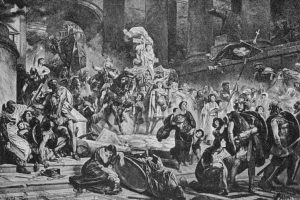In 2007 New Jersey became the first state to abolish the death penalty since it was reinstated in 1976, joining 12 other states that never reintroduced the practice when given the option. While many other states weigh their options and as advocates continue to work toward full repeal, here’s a look back on the country’s history of capital punishment:
1608 – The first recorded execution in the colonies takes place in Jamestown, Virginia. Captain George Kendall is executed for suspicion of being a spy for Spain. Four years later, Sir Thomas Dale, governor of Virginia, enacts the “Divine, Moral, and Martial Laws” making minor crimes such as stealing grapes, killing chickens, or trading with Native Americans capital offenses.
1778 – Thomas Jefferson proposes an amendment to Virginia’s death penalty laws that would limit capital punishment to only murder and treason. The bill is defeated by one vote.
1834 – Pennsylvania becomes the first state to remove executions from the public eye by moving them to state penitentiaries.
1838 – Discretionary death penalty statutes are adopted in Tennessee. At the time, these were seen as a major reform. Prior to the statutes, all states required the death penalty for anyone who had been convicted of a capital crime, regardless of the circumstances.
1846 – Michigan becomes the first state to abolish the death penalty.
1890 – William Kemmler is the first man executed by the electric chair, which had been developed in New York in 1888.
1907–17 – During a period of progressive reform in the United States, six states completely repeal the death penalty, while three others limit its use to the rare crimes of treason and first-degree murder of a law enforcement official. However, due to rising tensions in the face of World War I and the Russian Revolution, five of the six abolitionist states would reinstate the death penalty by 1920.
1924 – Seeking a more humane way of conducting executions, Nevada becomes the first state to use lethal cyanide gas to execute Gee Jon. A gas chamber had to be constructed after attempts to pump gas into Jon’s cell while he slept were unsuccessful.
1930s – A resurgence in the use of the death penalty results in part from criminologists beginning to argue that the death penalty was a necessary social measure. The decade of the 1930s averaged 167 executions per year, the highest in American history.
1966 – Support for the death penalty in the United States reaches an all-time low after a Gallup poll measures support at just 42 percent. After the Universal Declaration of Human Rights in 1948, which proclaimed a “right to life,” global support of the death penalty began to decrease, especially as many nations across Europe began to enact de facto moratoriums on the death penalty.
1972 – The landmark Furman v. Georgia Supreme Court case effectively suspends the death penalty. The court ruled that Georgia’s death penalty statute, which included discretionary laws, allowed for arbitrary sentencing, and that as a result the punishment was therefore “cruel and unusual,” violating the Eighth Amendment.
1976 – After states had begun to rewrite their statutes in the wake of Furman, the Gregg v. Georgia decision declares new death penalty statutes in Florida, Georgia, and Texas to be constitutional, and the death penalty is reinstated. The death penalty itself is found to be constitutional with respect to the Eighth Amendment.
1982 – In Texas, Charles Brooks becomes the first person executed by lethal injection. Five years prior, in 1977, Oklahoma had become the first state to adopt lethal injection as a means of execution.
1994 – President Bill Clinton signs the Violent Crime Control and Law Enforcement Act into law. Title VI of this act, the Federal Death Penalty Act, created 60 new death penalty offenses, including several linked to terrorism.
1999 – While in St. Louis in January on a visit to the United States, St. John Paul II calls for an end to the death penalty. In a homily, he said, “I renew the appeal I made most recently at Christmas for a consensus to end the death penalty, which is both cruel and unnecessary.”
Source: Death Penalty Information Center











Add comment